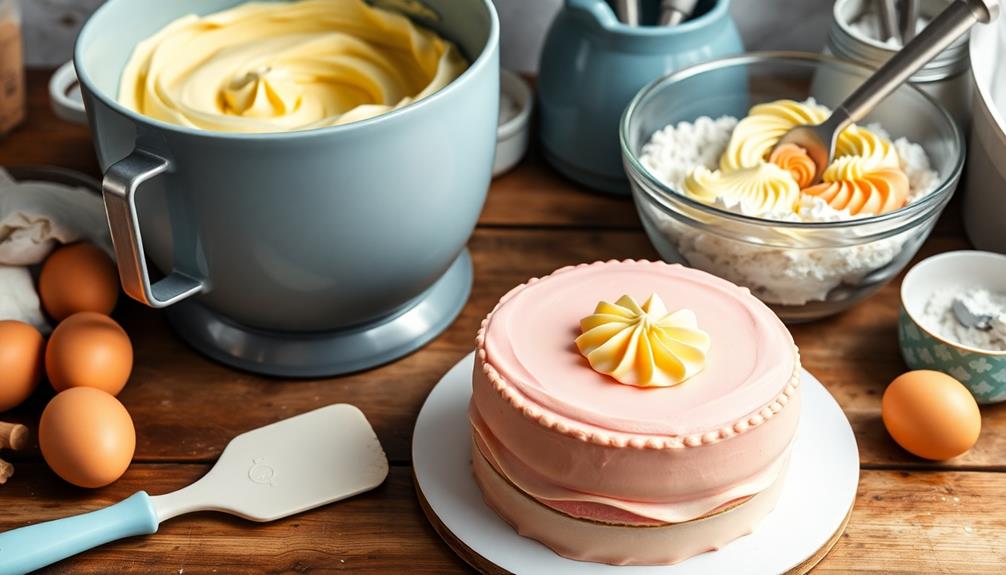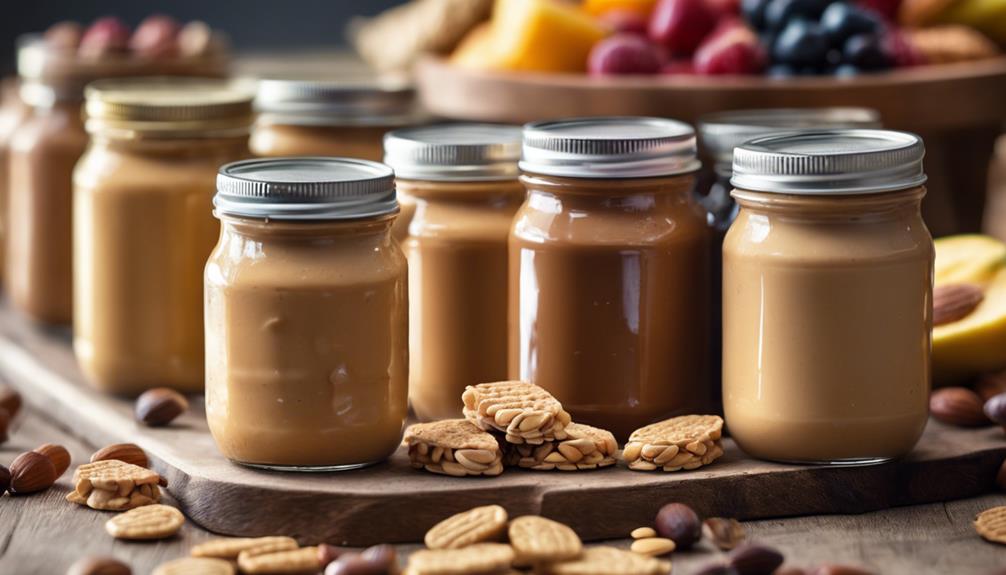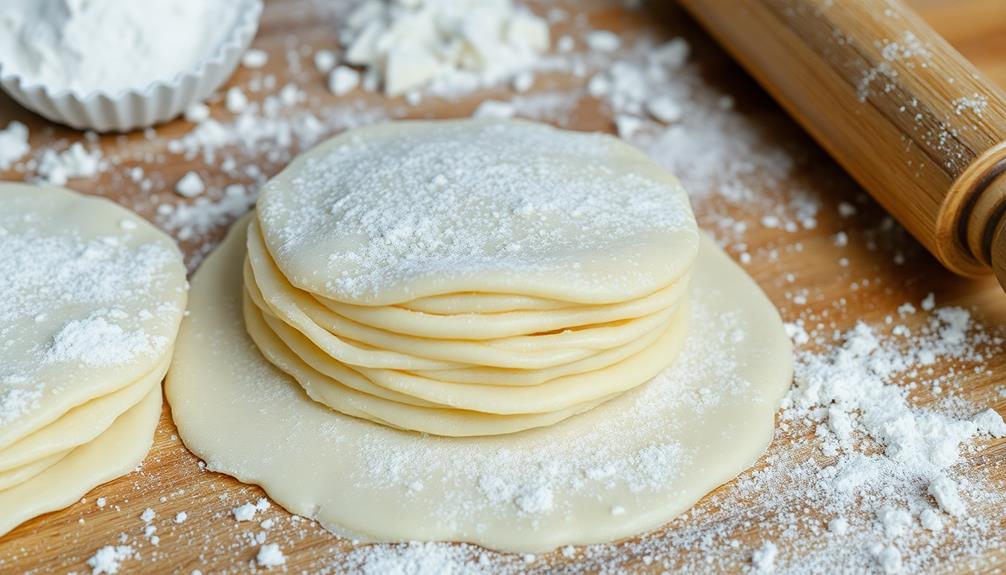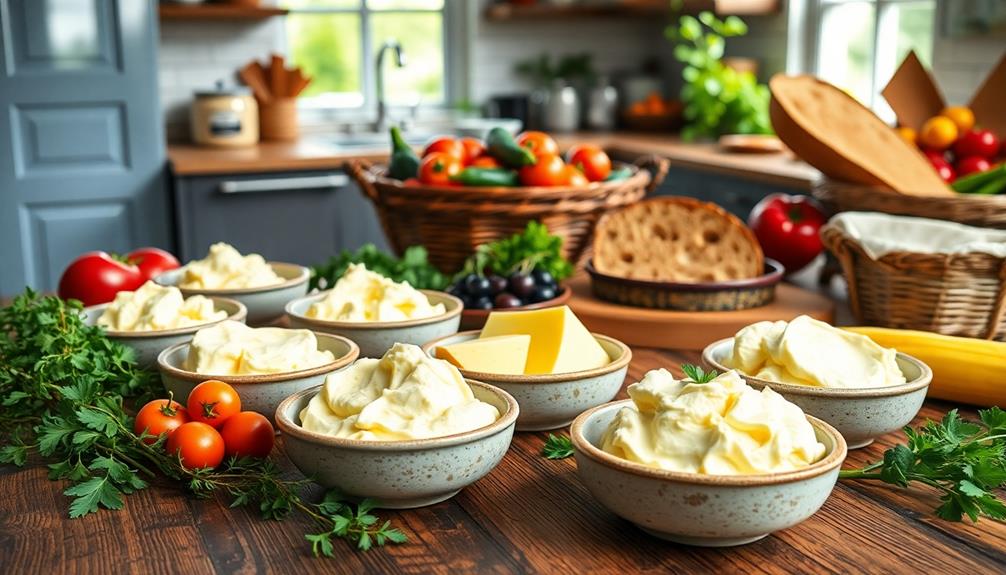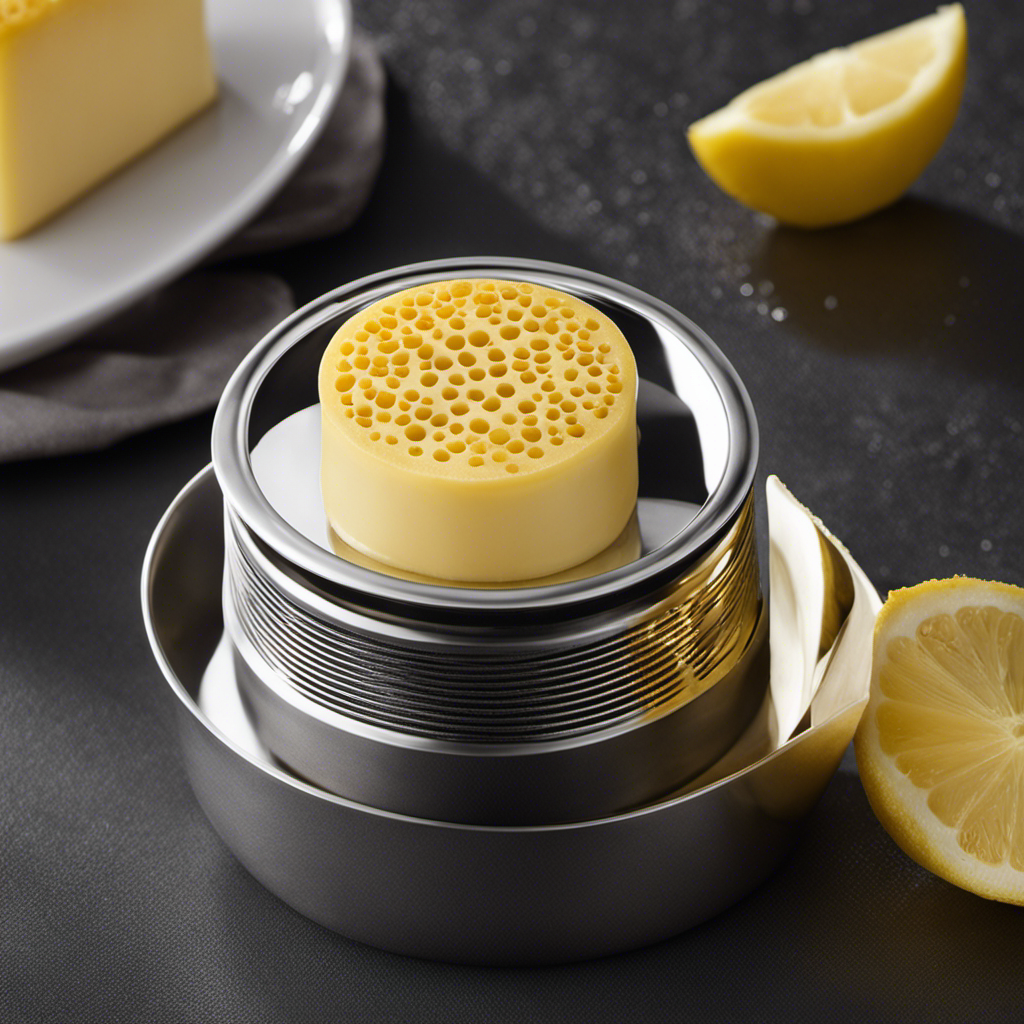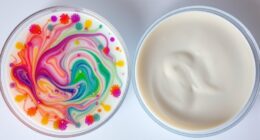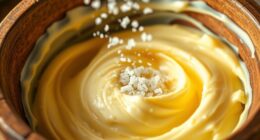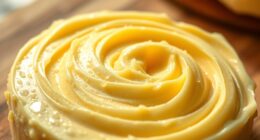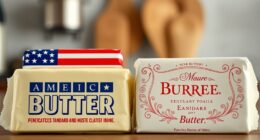To create the perfect buttercream, start with room temperature unsalted butter. Mix it on medium speed until creamy, then gradually add sifted powdered sugar for sweetness. Keep mixing for about 3-5 minutes to achieve that light, airy texture. If it's too thick, adjust with a splash of milk or cream. Flavor it with vanilla extract, or get creative with almond or cocoa powder. Avoid common pitfalls like using cold ingredients or forgetting to sift the sugar. With these tips, you'll get a silky, smooth frosting every time. Stick around, and you'll discover even more helpful techniques!
Key Takeaways
- Use room temperature unsalted butter for a creamy base to prevent lumps and ensure easy mixing.
- Gradually add sifted powdered sugar while mixing on medium speed to achieve a fluffy texture.
- Incorporate flavorings like vanilla extract or cocoa powder to enhance taste and create variations.
- Monitor mixing time, aiming for 3-5 minutes for a light and airy buttercream consistency.
- Adjust thickness with milk or powdered sugar as needed to achieve a silky, spreadable texture.
Essential Ingredients for Buttercream
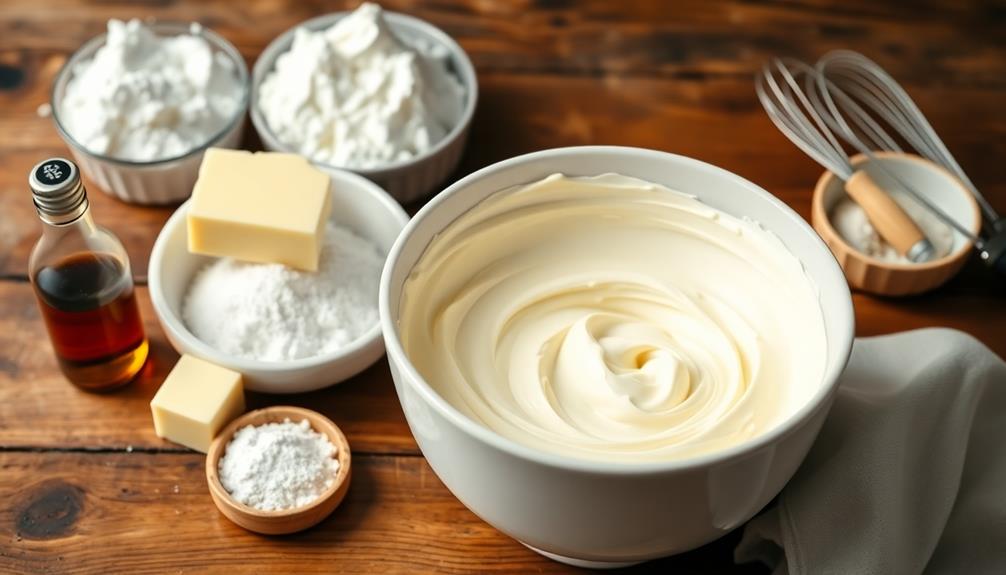
To create a perfect buttercream, you'll need a few essential ingredients that work together to achieve that smooth, creamy texture.
First, grab unsalted butter. Using unsalted helps you control the sweetness since you can add salt later if needed. Make certain it's at room temperature to guarantee it blends easily.
Next, you'll need powdered sugar, which gives buttercream its sweetness and fluffy consistency. Sift it before adding to avoid any lumps that could ruin your final product.
For flavor and to help with the mixing process, a splash of vanilla extract is a must. It adds depth to the taste and complements the sweetness.
Finally, a little milk or heavy cream will help you achieve the desired consistency. Start with a small amount and adjust as needed.
If you want to experiment, you can incorporate other flavorings, like almond extract or cocoa powder, to create different variations.
With these ingredients in hand, you're ready to whip up a delicious buttercream that'll elevate any cake or cupcake.
Just remember, the quality of your ingredients will directly impact the final result, so choose wisely!
The Right Tools to Use
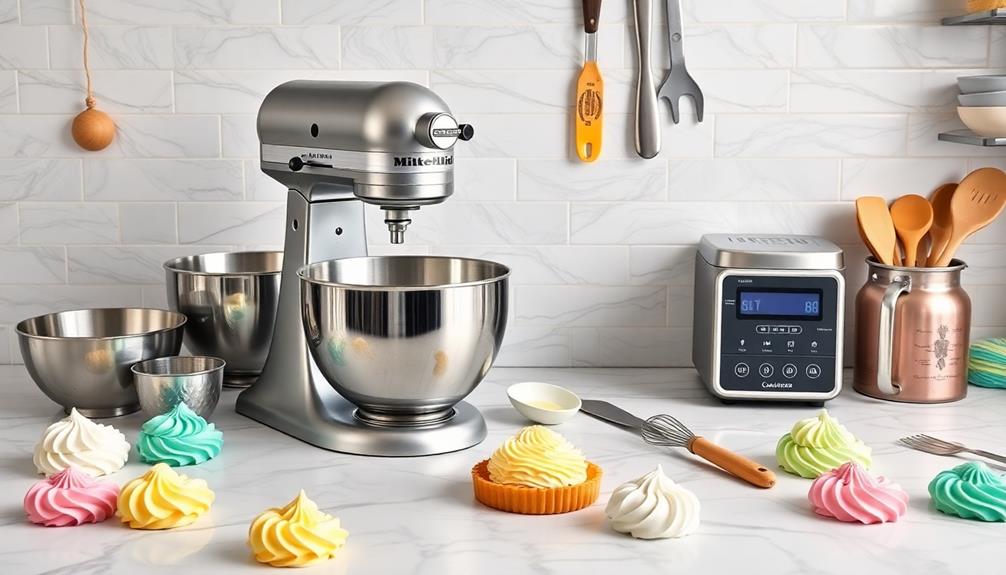
The Right Tools to Use
When it comes to making perfect buttercream, having the right tools on hand can make all the difference in the world. You'll find that using the right equipment not only speeds up the process but also guarantees a smooth and fluffy texture.
For best results, consider using higher fat content butter to enhance the richness and flavor of your buttercream. Here's what you need to get started:
- Stand Mixer: A powerful stand mixer takes the hard work out of mixing and aerating your buttercream.
- Spatula: A sturdy spatula helps you scrape down the sides of the bowl, making sure all ingredients are well incorporated.
- Mixing Bowls: Use a couple of medium-sized mixing bowls to separate your ingredients and keep your workspace organized.
- Measuring Cups and Spoons: Accurate measurements are essential for achieving that perfect consistency, so don't skimp on these.
- Piping Bags and Tips: If you plan to decorate with your buttercream, having piping bags and various tips lets you get creative with designs.
With these essential tools, you'll be well-equipped to whip up some delicious buttercream that's perfect for any cake or cupcake.
Now, let's get ready to jump into the mixing process!
Step-by-Step Mixing Process
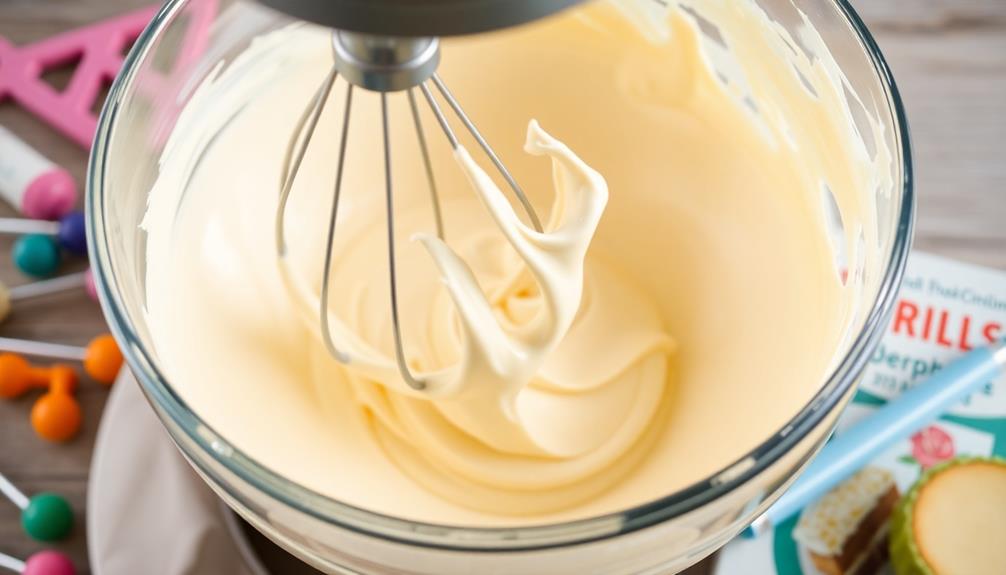
Now that you've got the right tools, let's focus on the essential ingredients you'll need and the best mixing techniques to create perfect buttercream.
Understanding these components will help you achieve that smooth, creamy texture everyone loves.
Essential Ingredients Overview
Understanding the essential ingredients for perfect buttercream is important for achieving that smooth, creamy texture you desire. Each ingredient plays an important role in creating the right consistency and flavor that'll elevate your baked goods.
Additionally, using high-quality ingredients can enhance your overall baking experience, similar to how air purifiers improve indoor air quality for a healthier home environment.
Here's a quick overview of the must-have ingredients:
- Unsalted Butter: This is your base, providing the rich flavor and creamy texture.
- Powdered Sugar: It sweetens your buttercream while ensuring a smooth finish; no gritty texture here!
- Heavy Cream or Milk: Adding this helps to achieve the perfect spreadability, making your buttercream silky.
- Vanilla Extract: A splash of this enhances the flavor, giving your buttercream that classic, sweet aroma.
- Salt: Just a pinch balances the sweetness and enhances the overall flavor.
Make sure you use high-quality ingredients; they'll make a noticeable difference in your final product.
With these essentials on hand, you're one step closer to creating the perfect buttercream for your cakes and cupcakes. Enjoy the process, and don't hesitate to experiment with flavors and colors to make it your own!
Mixing Techniques Explained
To achieve that perfect buttercream texture, mastering the mixing techniques is essential. Whether you're using a stand mixer or a hand mixer, the process can make or break your buttercream. Here's a step-by-step mixing guide to help you out.
| Step | Action | Result |
|---|---|---|
| 1 | Start with softened butter | Creamy base for easy mixing |
| 2 | Mix on medium speed | Fluffy texture forms quickly |
| 3 | Gradually add powdered sugar | Sweetness blends well, no lumps |
Begin by beating your softened butter until it's creamy. This usually takes about 2-3 minutes. Next, you'll want to gradually add in the powdered sugar, mixing on low speed to avoid a sugary cloud. Once combined, increase the speed to medium and whip it for another 3-5 minutes. This aeration is key to light, fluffy buttercream.
Achieving the Perfect Consistency
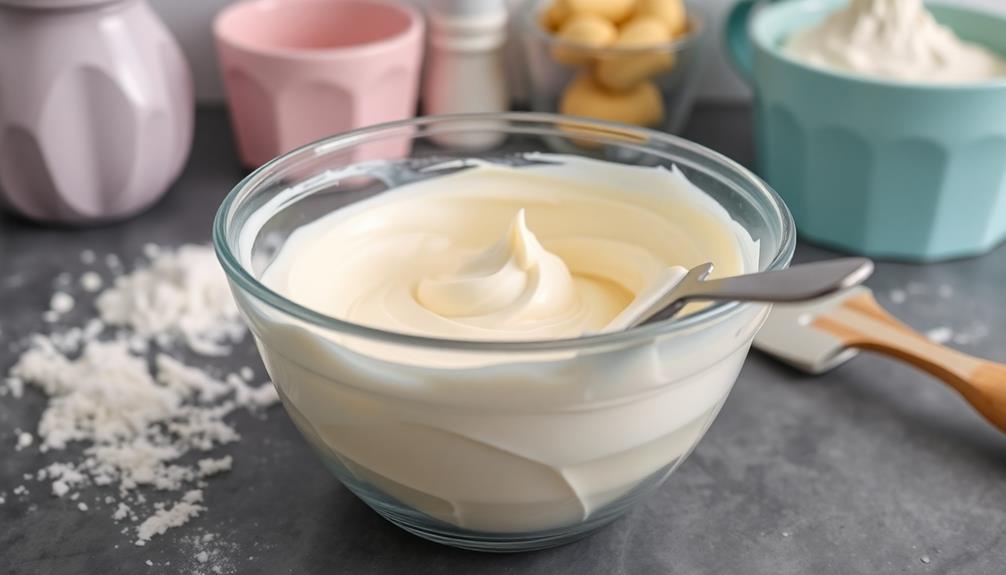
Achieving the perfect consistency in buttercream requires careful attention to temperature and mixing time. Start by ensuring your butter is at room temperature—this makes it easier to cream with sugar. If your butter's too cold, you'll end up with lumps; if it's too warm, your buttercream might be too soft. Using butter in baking will greatly enhance the flavor and texture of your buttercream, making it an essential ingredient.
When mixing, aim for a light and fluffy texture. This usually takes about 3-5 minutes on medium speed. If your buttercream feels too thick or dry, add a splash of milk to loosen it up. Conversely, if it's too runny, you can add more powdered sugar for thickness.
To visualize the ideal consistency, think of:
- Silky smoothness that glides on cakes
- Stiff peaks that hold their shape
- Spreadable texture that doesn't drip
- Lightness that feels airy on the palate
- Velvety finish that invites a second bite
Keep these elements in mind as you mix, and you'll find that perfect balance. Remember, practice makes perfect, so don't hesitate to adjust as needed until you achieve that dreamy buttercream consistency!
Flavoring Your Buttercream
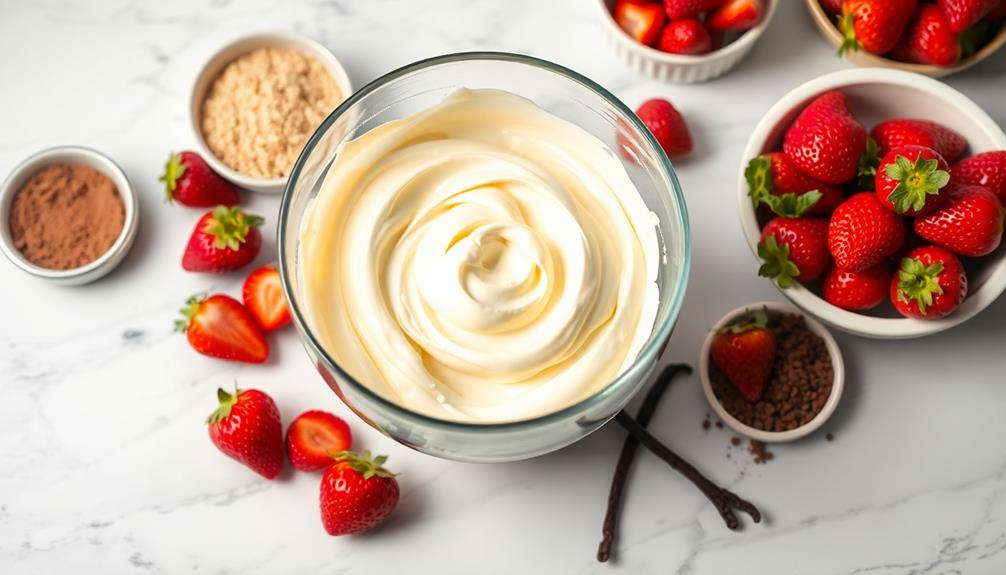
When it comes to flavoring your buttercream, you have plenty of options to explore.
You can enhance your frosting with extracts and flavor oils or even use natural ingredients for a unique twist.
Let's take a closer look at how these choices can elevate your buttercream to the next level.
Extracts and Flavor Oils
Flavoring your buttercream can elevate your desserts from ordinary to extraordinary, and using extracts and flavor oils is a simple way to achieve that. These concentrated flavorings pack a punch, allowing you to customize your buttercream to match your dessert or personal taste.
When choosing extracts and flavor oils, consider the following options to create mouthwatering sensations:
- Vanilla Extract: A classic choice that adds warmth and depth.
- Almond Extract: Offers a nutty, sweet flavor that complements many baked goods.
- Peppermint Oil: Perfect for a revitalizing twist, especially in chocolate desserts.
- Lemon Extract: Brightens your buttercream and provides a zesty kick.
- Hazelnut Flavor Oil: Adds a rich, toasty note, perfect for coffee-flavored treats.
Start by adding a few drops or teaspoons to your buttercream, tasting as you go. Remember, a little goes a long way!
Adjust the amount based on your preference and the strength of the flavoring. With the right extracts and oils, you'll transform your buttercream into a delightful treat that'll make your desserts truly unforgettable.
Natural Ingredients Options
There are plenty of natural ingredients you can use to flavor your buttercream, making it both delicious and appealing. By opting for these natural options, you can elevate your frosting without relying on artificial additives. Here are some great choices:
| Flavoring Ingredient | How to Use | Flavor Profile |
|---|---|---|
| Pureed Fruit | 1/4 cup | Fresh and fruity |
| Cocoa Powder | 1/4 cup | Rich and chocolatey |
| Fresh Herbs | 1-2 tbsp | Unique and fragrant |
To incorporate these ingredients, simply mix them into your buttercream while beating in the powdered sugar. When using pureed fruit, keep in mind that it might add moisture, so you may need to adjust the sugar accordingly. Cocoa powder can add a delightful chocolate flavor without compromising texture. Fresh herbs, like mint or basil, can create an unexpected twist that'll impress your guests.
Experiment with different combinations to find what you love best! By using these natural flavoring options, you'll create a buttercream that's not only tasty but also a reflection of your creativity. Enjoy the process!
Common Mistakes to Avoid
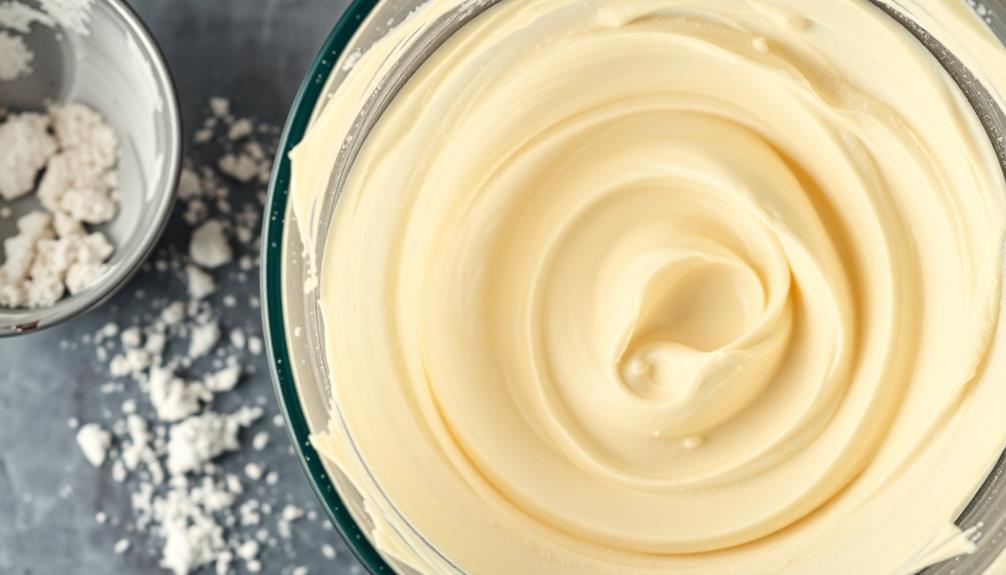
Crafting the perfect buttercream requires attention to detail, and avoiding common pitfalls is essential for achieving that ideal texture and flavor. Here are some mistakes you should steer clear of:
- Overmixing: Whipping too long can introduce excess air, resulting in a fluffy but unstable texture.
- Using cold ingredients: Cold butter or cream can lead to lumps, so let them reach room temperature first.
- Not sifting powdered sugar: If you skip this step, you might end up with a gritty buttercream that's not smooth.
- Ignoring the type of butter: Not all butters are created equal; using margarine or low-fat butter can compromise flavor and texture.
- Forgetting to taste: Always sample your buttercream during preparation. Adjust sweetness or flavors as needed for that perfect finish.
Frequently Asked Questions
Can I Use Margarine Instead of Butter for Buttercream?
Yes, you can use margarine instead of butter for buttercream. Just keep in mind that the flavor and texture might differ slightly. Experimenting will help you find the right balance for your frosting needs.
How Long Can Buttercream Be Stored in the Fridge?
You can store buttercream in the fridge for about one to two weeks. Just make sure it's in an airtight container. Before using, let it come to room temperature and re-whip if necessary.
Is It Possible to Freeze Buttercream?
Yes, you can freeze buttercream! Just scoop it into an airtight container or freezer bag, and it'll stay fresh for up to three months. When you're ready, thaw it in the fridge before using.
What Types of Cakes Pair Best With Buttercream?
What's better than a rich chocolate cake topped with buttery frosting? Vanilla, red velvet, and carrot cakes also shine with buttercream. You'll love how the creamy texture enhances every bite, making your desserts unforgettable!
Can I Color Buttercream With Gel Food Coloring?
Yes, you can color buttercream with gel food coloring! It provides vibrant hues without altering the consistency. Just add a small amount, mix well, and adjust until you achieve your desired color intensity. Enjoy decorating!
Conclusion
With the perfect buttercream in your arsenal, you can transform any cake into a masterpiece that dazzles the taste buds. Remember, practice makes perfect, so don't be afraid to experiment with flavors and techniques. By avoiding common pitfalls, you'll whip up a frosting that's as smooth as silk and as sweet as a summer breeze. Now, roll up your sleeves and let your creativity flow—your next baking adventure awaits!
